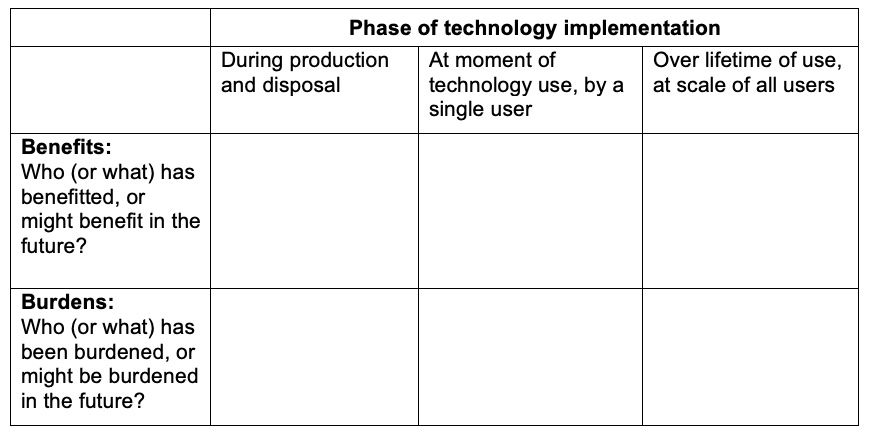Identifying and mitigating discriminatory design impacts #
One goal of ME 30 is to empower you to use tools of electronics and robotics to design new technologies. We acknowledge that with that power comes much responsibility, including the responsibility to avoid discriminatory design – that is, the creation of a technology whose burdensome impacts fall disproportionately on individuals who belong to a marginalized group, such as people of color.
Stakeholder Mapping #
Stakeholder mapping presents one tool for analyzing a technological design for its potential discriminatory impacts. In this activity, you’ll work in a team to analyze different technologies using stakeholder mapping as a common framework to identify discriminatory benefits/burdens.
Step 1 – Stakeholder Identification #
Analyzing stakeholders is a practice that can help engineers recognize the variety of individuals groups that have an interest in an engineering decision, whether they are aware of that interest or not. When making a map, the first step is to identify potential stakeholders. These could include potential customers, users, laborers, community residents, manufacturers, suppliers, or competitors related to a product. Stakeholders can even be non-human, like wildlife or the environment.
The most generative stakeholder analysis, consider not just the direct operation of the technology by a single user but also its production, disposal, and use at scale.
As designers identify stakeholders, benefits, and burdens, they consider:
- labor required to produce, operate, and dispose of the technology
- energy consumption required to produce, operate, and dispose of the technology
- materials used in the technology
- accessibility of the technology
- safety of the technology

Step 2 – Interest and Power Analysis #
Different stakeholders can be located on a 2-dimensional plot of relative interest (the importance to stakeholder) vs power (influence over technology). Weighing potential benefits and burdens according to stakeholder position can help engineers come to a decision on whether or not to pursue a project or design change.
Interest means how much a stakeholder will be affected by the technology, whether or not they are aware of that impact.
Power means how much influence a stakeholder has on the technology.

In-Class Exercise for Nov. 8 #
Part A. (20-25 min) #
For each of the three technologies, assign one student on your team to conduct stakeholder mapping according to Steps 1 and 2 above. Use specific information from the provided resources as sources of evidence for your analysis. You are welcome to conduct additional research on the technology as well.
Record your analysis on the handout provided. Take a photo of your work and upload it to the Canvas assignment for today’s activity. (Each student should upload a photo individually.)
Technology #1: Automatic hand soap dispenser
Resources:
- Product description: https://www.newegg.com/p/0BK-017D-00180
- Infrared sensors explained: “The Right Tool for the Job: Active and Passive Infrared Sensors” (2018). Arrow Electronics. https://www.arrow.com/en/research-and-events/articles/understanding-active-and-passive-infrared-sensors
Technology #2: “Care robot” for elderly people in Japan
Resources:
- Product description for the Pepper robot: https://www.aldebaran.com/en/pepper
- “Inside Japan’s long experiment with automating elder care.” Wright, J. (Jan., 2023). MIT Technology Review. https://www.technologyreview.com/2023/01/09/1065135/japan-automating-eldercare-robots/
If the MIT Tech Review link doesn’t work for you, access a PDF version here.
Technology #3: Electric vehicle batteries
Resources:
- “The EV Battery Supply Chain Explained.” Carreon, A. (May, 2023). Rocky Mountain Institute. https://rmi.org/the-ev-battery-supply-chain-explained/
- “EV Batteries 101: The Basics.” Carreon, A. (Mar., 2023). Rocky Mountain Institute. https://rmi.org/ev-batteries-101-the-basics/
Part B. (15-20 min) #
Within your team, share your findings across the three technologies and discuss the following question:
How does the potential for discriminatory benefits & burdens compare across automatic soap dispensers, elder care robots, and EV batteries? To what extent is each of these technologies an example of discriminatory design, if at all?
After your group discussion, post your answer in the Canvas quiz for today’s activity.
Part C. (~20 min) #
Click the box below to read about a technology design proposal. Use stakeholder analysis (Steps 1 and 2 above) to make a recommendation about whether to proceed with this design work.
After your group discussion, post your own final recommendation in the Canvas quiz for today’s activity.
References #
Benjamin, R. (2019). Race After Technology: Abolitionist Tools for the New Jim Code. Polity.
O’brolcháin, F., De Colle, S., & Gordijn, B. (2019). The ethics of smart stadia: a stakeholder analysis of the Croke Park project. Science and engineering ethics, 25(3), 737-769.
Hoople, G. D., & Choi-Fitzpatrick, A. (2022). Drones for Good: How to Bring Sociotechnical Thinking into the Classroom. Springer.
Riley, D. (2008). Engineering and Social Justice. Morgan Claypool.